Harvesting From Nature; The Bounty Around Us
One of the most exciting concepts of backwoods living is collecting and preserving food from the wild. Wild foods are high in both vitamin content and flavor, but unlike their domestic cousins from the garden, wild greensand fruits are available during a shorter season of harvest. Why? Because man has not tampered with them genetically to alter size, flavor, quality, or for that matter, made them so tough they can withstand being packed and shipped across the country without bruising. Just the opposite wild foods are fragile and must be handled gently and prepared quickly to retain their natural goodness. It is beyond the scope of this article to include all wild foods, so seek additional information on native fruits and herbs available in your area and learn more about them. Also, I do not intend to touch on wild mushrooms or morels since a wrong selection can prove fatal.
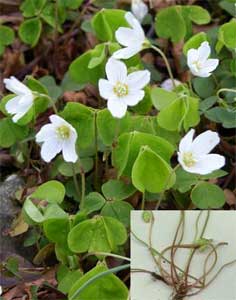 Beginning with wild greens—if carefully handpicked when young and tender, they are a delight to the palate, but if picked late in the season they tend to taste bitter. Some greens transplant well and I dig up those found on our land and move them near the house for ease in harvesting year after year. I especially enjoy growing wild garlic and wild onion for soups and salads. These I harvest by snipping tiny bits with kitchen shears when needed, or in the case of wild garlic, I snip large amounts and freeze them in polyethylene bags. Wild garlic does not form the multi-sectioned bulb wearer accustomed to seeing in the supermarket. Instead it has a single bulb which is mildly garlic flavored with long slender leaves that are as valued as the bulb.
Beginning with wild greens—if carefully handpicked when young and tender, they are a delight to the palate, but if picked late in the season they tend to taste bitter. Some greens transplant well and I dig up those found on our land and move them near the house for ease in harvesting year after year. I especially enjoy growing wild garlic and wild onion for soups and salads. These I harvest by snipping tiny bits with kitchen shears when needed, or in the case of wild garlic, I snip large amounts and freeze them in polyethylene bags. Wild garlic does not form the multi-sectioned bulb wearer accustomed to seeing in the supermarket. Instead it has a single bulb which is mildly garlic flavored with long slender leaves that are as valued as the bulb.
Wood sorrel and blue violets are not only pretty when planted around the house, but are tasty in salads and make pleasant herb teas. To preserve the delicate leaves, dry them as you would any herb and store in small jars away from light.
Many wild greens are harmful or biter if not cooked properly. Greens such as dandelion, sour dock, wild lettuce, lamb’s quarter (wild spinach), pursuance, wild mustard and the tops of wild beets require two or three changes of water to make them palatable. Pick only the young, tender shoots and leaves. Wash them in several changes of water to remove all dirt and grit. Place greens in apt and cover with water. Add salt if desired. Boil until tender, and drain. Add fresh, clear water to the pot and simmer for ten minutes more. Drain a second time and add any spices or flavorings such as onions, bacon or vinegar.
The dandelion is rich in vitamin A, with almost twice the vitamin A content of spinach. The early spring leaves are a delicacy, while those growing later in the season are quite bitter, thus the change of water when cooking, even up to three water changes.
Many seeds from native trees are edible and can be ground into flour. This was a staple of early pioneers and Indians. For example, the mesquite tree of the Southwest desert was prized by early Indians and Mexicans for its long bean pod. By drying and grinding the pod and its contents, a nutritious breadstuff is made. The pod can be cooked while still green and is considered a delicacy. Although I have not tried the mesquite bean, while living in Arizona I experimented with the bean from the palo verde tree, and found it quite flavorful if separated from the hull and eaten raw when still green and tender as one would eat English sweet garden peas. I even ground the dry bean into a flour using a food chopper and mixed the product with regular flour. This produced a more nut-like flavor in home baked bread.
The honey locust produces a similar pod, reaching up to 15 inches in length and spiral shaped. The pod is enjoyed by kids who find it sweet when chewed. This seed pod (sometimes called the Screw Bean) can be infested with insect larvae, so inspect carefully before you harvest it. Insect invasion is evidenced by small holes bored into the pod. It was used the same as mesquite and palo verde by early settlers and Indians, and is believed to be the locust that John the Baptist lived on in the desert.
The roots of many plants are also edible, such as the Jerusalem artichoke, which is a potato-like tuber.
The cattail, both broad-leaved and narrow-leaved varieties, yields an edible root which is starchy. The root can be roasted or dried and ground into flour. The young, tender shoots can be peeled and served in salad, or steamed or stir-fried like asparagus. Choose only the youngest, most tender shoots. In the early spring here in southeast Oklahoma, when green browse is still scarce, whitetail deer come nightly to or pond to relish the early sprouting cattails. On these days I arise early and take a walk to the pond. Strolling its boundaries and surveying the animal tracks and paw prints in the mud, I read them like most people read their morning newspaper. They tell me that not only have deer visited the pond, but that a flock of wild turkey and a fox stopped for water.
There are countless numbers of fruiting trees and berries in the wild that offer food for the taking. One has only to remember the time of harvest to collect more than a winter’s supply. Wild plums have a very short season. They seem to ripen almost overnight after being on the tree for ages. Once they ripen, they drop. Be ready to harvest and preserve on a moment’s notice. I like to make jam from this sometimes tart fruit, or can it with sugar for serving at breakfast on some cold winter morning along with hot waffles and honey.
The staghom sumac is supposed to make a lemonade drink. The berries are quite sour in the early summer when they exude a sticky substance, and my children love to suck on them. However, it is the root of the sumac—not the berry—which is used for making the drink. I have tried steeping the berries with poor results; perhaps pressing them to extract the sour oil would be preferable.
 There are wild fruits and berries for making delicious jellies and fruit leathers, canning with or without sugar, and freezing. Most abundant on our backwoods farm is the wild and sometimes pesky persimmon. I’ve always heard that the persimmon must pass through a freeze before it becomes sweet. Not so. Just like any other fruit, the persimmon will ripen and sweeten in its time. Since it is a late fall producer, the crop is usually not ripe until after a frost or early freeze. It could be that this is where it received its reputation for not being edible until after a freeze, We have trees on our place that produce large, succulent and juicy fruit, while nearby there are trees that have a much smaller, drier fruit. This is probably due to genetics, as both varieties receive the same amount of rainfall and grow in identical rocky soil. Persimmons are high in potassium and vitamins A and C.
There are wild fruits and berries for making delicious jellies and fruit leathers, canning with or without sugar, and freezing. Most abundant on our backwoods farm is the wild and sometimes pesky persimmon. I’ve always heard that the persimmon must pass through a freeze before it becomes sweet. Not so. Just like any other fruit, the persimmon will ripen and sweeten in its time. Since it is a late fall producer, the crop is usually not ripe until after a frost or early freeze. It could be that this is where it received its reputation for not being edible until after a freeze, We have trees on our place that produce large, succulent and juicy fruit, while nearby there are trees that have a much smaller, drier fruit. This is probably due to genetics, as both varieties receive the same amount of rainfall and grow in identical rocky soil. Persimmons are high in potassium and vitamins A and C.
When harvesting persimmons, pinch the fruit gently while still on the tree. If it is soft and yielding, chances are it is ripe and sweet, ready for harvest.
Another way is to shake the tree vigorously. A shower of ripe persimmons will drop to the ground for easy gathering. These are a favorite food for wildlife, so any missed fruit will be eaten by ’possum, coon, bear or fox. Even our dogs and goats enjoy a persimmon or two. And Mickey our pet opossum relishes these golden sweet fruits in season, almost as much as he enjoys hot dogs.
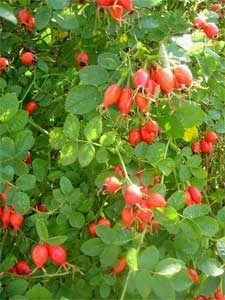 Another source of vitamin C is the rose hip. Rose hips are more abundantly produced by wild roses than domestic ones. Allow the hips to ripen before harvesting and then experiment with their multiple uses, such as potpourri, jam, jelly, tea, wine or dried arrangements. When preparing the hips for jam or jelly, remove the blossom ends, stems, and leaves. Wash and store in an airtight container in the refrigerator until ready to use.
Another source of vitamin C is the rose hip. Rose hips are more abundantly produced by wild roses than domestic ones. Allow the hips to ripen before harvesting and then experiment with their multiple uses, such as potpourri, jam, jelly, tea, wine or dried arrangements. When preparing the hips for jam or jelly, remove the blossom ends, stems, and leaves. Wash and store in an airtight container in the refrigerator until ready to use.
The hips are used with the seeds removed unless the recipe calls for hips and seeds. To remove the seeds, cut the fruit in half and scoop out the seeds, or remove a portion of the top of the hip and using a sharp knife, carefully remove the seeds. Don’t discard the seeds, for they are a rich source of vitamin E and can be used for adding additional vitamin E to other dishes. Grind and boil them in a small amount of water, then strain through a layer of cloth. Use this solution as part of the liquid called for in other recipes.
To make rose hip jam, measure and cook clean rose hips in an equal amount of water. Since vitamin C is easily destroyed, never let it come in contact with copper or aluminum. Use wooden spoons and stainless steel knifes. Cook the hips until tender and mash. Force the resulting pulp through a fine sieve and add one cup of sugar for each cup of pulp. Cook again until the pulp thickens to jam consistency. Pour into sterilized jars and seal.
 Wild grapes are almost impossible to harvest because they climb to the tops of the tallest trees. There they stay to feed birds and climbing wildlife. However, we are fortunate to have several wild grape vines growing near the house which climb onto trellises the former owner built for the purpose. Like the persimmon, these grapes offer two distinct varieties—one is small and hard, while the other produces large clusters of juicy tart grapes. The difference here is that the better producing vines are watered by kitchen gray water, while the other must survive on natural rainfall. Wild grapes make excellent juice which can be canned or frozen for later use—or make it into jelly following your favorite recipe.
Wild grapes are almost impossible to harvest because they climb to the tops of the tallest trees. There they stay to feed birds and climbing wildlife. However, we are fortunate to have several wild grape vines growing near the house which climb onto trellises the former owner built for the purpose. Like the persimmon, these grapes offer two distinct varieties—one is small and hard, while the other produces large clusters of juicy tart grapes. The difference here is that the better producing vines are watered by kitchen gray water, while the other must survive on natural rainfall. Wild grapes make excellent juice which can be canned or frozen for later use—or make it into jelly following your favorite recipe.
Another good choice for making jelly is wild cherry. When fermented, it makes a pleasant wine. Although it is delicious eaten fresh, the fruit is small and mostly pit. Birds so love this fruit that they actually become intoxicated when it becomes overripe and ferments on the tree.
When seeking wild edible plants, there are a few things you should bear in mind for the sake of preserving the environment.
- Take no more plants than are necessary, and harvest only the leaves or fruit when possible, leaving the root to reproduce again.
- Don’t harvest the same location year after year.
- Don’t disturb wildlife dens or homes.
- Never disturb a member of an endangered species, for it is the only hope that some species have to increase their number.
- Leave the land and other things as you find them. Don’t kick over rocks, rotting stumps etc.
- Don’t cross private land without getting the owner’s permission, and when crossing a field repeatedly, always take a different route to prevent a beaten path.
- Keep dogs under control to protect wildlife.
Above all, do not leave tell-tale signs that might give away the location of a nest of birds or den of wildlife. Don’t reveal where you find something interesting, for then it’s no longer a secret, and the second visitor may not hold the same respect for the laws of nature as you do.
Even if you never harvest from the wild, the fun of discovery and the knowledge gained of the plants in your area are worth taking time from daily chores to indulge yourself and your children in this natural pleasure.
Additional Research:
 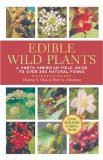 |
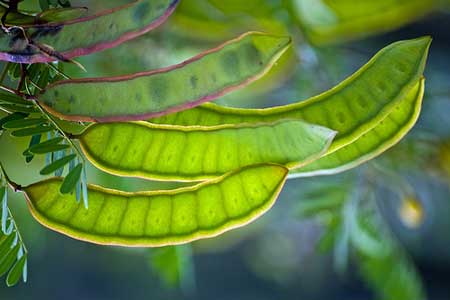
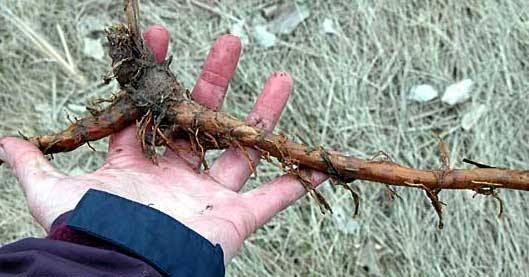
Leave a Reply